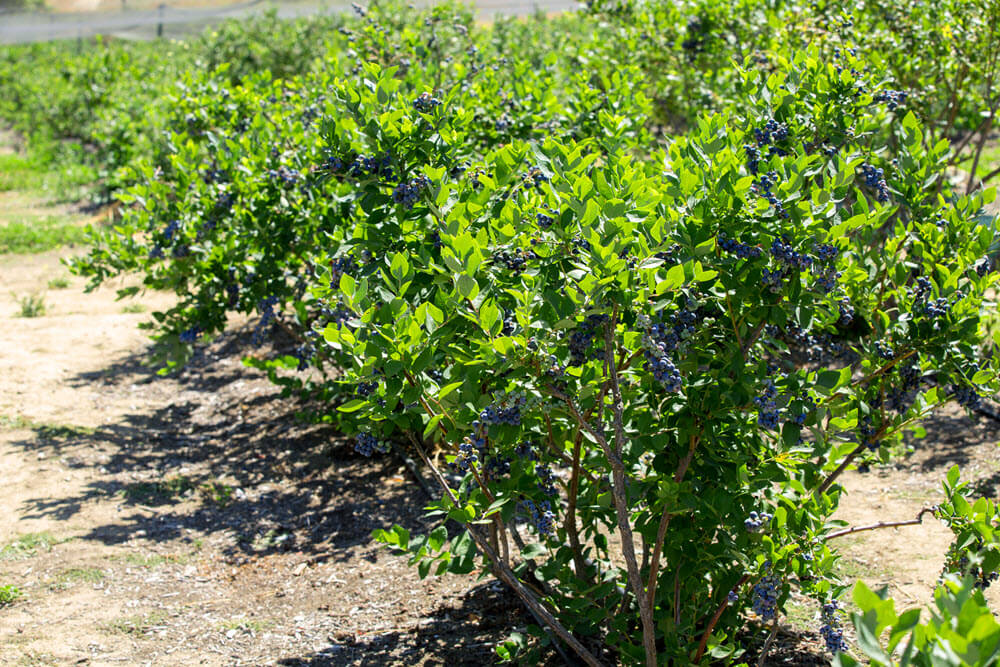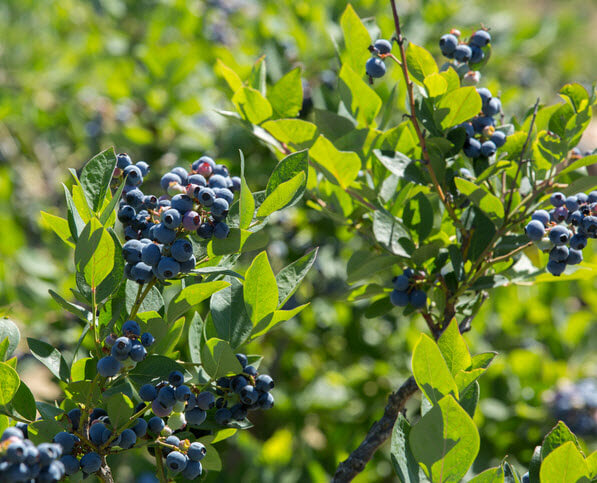
Starting Right with Blueberries
Posted by Grange Co-op on 25th Jan 2017
Blueberries bring a unique combination of delicious fruit and striking ornamental beauty to the garden and landscape. Blueberries are easy to grow, require little care, and are seldom bothered by pests. If a few basic steps are followed, your plants can thrive and last a lifetime.
 Allow adequate spacing around each bush for maximum yield
Allow adequate spacing around each bush for maximum yield
VARIETIES: Choose varieties suited to your area. You may want to select varieties that ripen at different times. Bushes with brilliant fall color of different growth habits offer the gardener lots of choices to use throughout the landscape. For blueberry lovers, allow at least two plants per family member.
SITE SELECTION AND PREPARATION: Select a sunny location in well-drained soil that is well-worked. Best results will be obtained by keeping the root zone moist throughout the growing season. Where the soil is poor or marginally drained, raised beds 34' wide and 8-12" high work well.
SPACING: Plant 2 1/2 ' apart to form solid hedgerows or up to 6' apart as individual specimens. If planted in rows, allow 8-10' between rows.
PLANTING: For container stock, remove from pot and lightly roughen up the outside surface of the rootball. Set the top soil line of the plant about 1-2" higher than the existing ground and firm around rootball. Mound soil up along sides of exposed root mass. Water in well. For bareroot plants, spread roots out wide and shallow, cover with 1/2" of soil. Firm soil around roots and water well.
MULCHING: Blueberries do best with a 2-4" mulch over the roots to conserve moisture, prevent weeds and add organic matter. Bark mulch, acid compost, sawdust, grass clippings, etc. all work well. Repeat every other year.

Prune routinely to allow large berries to grow
PRUNING: It is important that blueberries get established before allowing them to bear fruit. Thereafter, they should be heavily pruned each year to avoid overfruiting, which results in small fruit or poor growth. Remove all blooms as they appear the first year. Thereafter, follow these steps after the leaves have dropped:
- Remove low growth around the base. If it doesn't grow, it gets pruned.
- Remove the dead wood and non-vigorous twiggy wood. Select for bright colored wood with long (at least 3") laterals. Remove blotchy colored wood.
- If 1/3 to 1/2 of the wood has not been removed by the above steps, thin out the fruiting laterals and small branches until this balance is obtained.
FERTILIZING: Blueberries like acid fertilizers such as Rhody or Azalea formulations. For newly planted stock, use 2 tablespoons of 10-20-10 (or similar fertilizer) in late spring or once plants are established. Careful! Blueberries are very sensitive to over-fertilization! For subsequent years, use 1 ounce of fertilizer for each year from planting to a total of 8 ounces per plant. Apply in early spring and again in late spring for best results. Always water well after fertilizing. For organic fertilizers, blood meal and cottonseed meal work well. Avoid using fresh manures.
CONTAINER PLANTING: If the soil type in your area is not suitable for blueberries, or your growing space is limited to deck or patio, container growing is an option. The half-high varieties, especially Northsky, lend themselves to this use. Northsky will fill out a container such as a half whiskey barrel when mature.
BLUEBERRY VARIETY DESCRIPTIONS:
| VARIETY | ZONE | FRUIT DESCRIPTION | MATURE SIZE | BUSH HABIT | FALL COLOR |
| Berkeley | 5-7 | late-mid, large, mild | 6-8' | open, spreading | yellow orange |
| Bluecrop | 4-7 | mid, large, sweet | 4-6' | upright, open | red |
| Bluegold | 4-7 | late, large | 3-4' | g lobe | orange |
| Bluejay | 7-9 | early mid, mild | 6-8' | spreading | orange-yellow |
| Blueray | 4-7 | mid, very large, sweet | 4-6' | upright, open | bright red |
| Bluetta | 4-7 | early, medium, tangy | 3-4' | globe | flame |
| Darrow | 5-7 | late, largest, juicy | 4-6' | upright, compact | orange |
| Duke | 4-7 | early, very large, mild | 4-6' | stocky, upright, open | orange |
| Earliblue | 5-7 | early, medium, mild | 4-6' | upright, compact | red |
| Elliott | 4-7 | late, large, tangy | 4-6' | upright, open | deep red/wine |
| Jersey | 7-9 | late, medium, sweet | 6-8' | upright, open | orange flame |
| Nelson | 4-7 | late-mid | 4-6' | upright | orange |
| Northblue | 3-7 | mid, medium | 2-3' | open | red |
| Northcountry | 3-7 | mid, small , "wild" flavor | 1.5-2' | compact, spreading | red |
| Northland | 3-7 | early-mid, medium, sweet | 3-4' | spreading | yellow-orange |
| Northsky | 3-7 | mid, small, "wild" flavor | 1-1.5' | compact, mound | red |
| Olympia | 5-7 | mid, medium, very sweet | 6-8' | spreading, globe | red-orange |
| Patriot | 3-7 | early, large, tangy | 3-4' | open, spreading | red |
| Sierra | 5-7 | mid, very large | 6-8' | upright | yellow orange |
| Spartan | 5-7 | early, very large, excellent flavor | 4-6' | upright | red |
| Sunrise | 5-7 | early, large | 4-6' | upright | red |
| Toro | 4-7 | mid, large | 4-6' | stocky, upright | crimson red |
| Vaccinium ang. | 5-7 | mid, small | 1' x 6' | ground cover | red |
